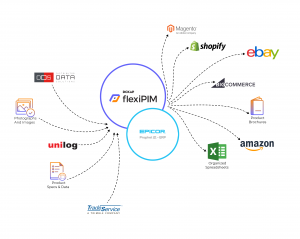Marketing has always been a comprehensive effort – particularly as the world gets increasingly digital. With more direct access to your customers unlike ever before, survival doesn’t just mean having an eCommerce presence but providing the most frictionless experience possible.
Thankfully, there also are many tools in an eCommerce brand’s arsenal to help provide this experience to your customers: one such increasingly crucial one being a PIM. If you’ve wondered how investing in one can help give your brand the extra advantage it needs to stay ahead of the curve, you’ve come to the right place. Read on to know more about the reasons to get a PIM for marketing your eCommerce brand.
Contents
What is a PIM tool?
A Product Information Management (PIM) Tool acts as a centralized repository of all your product content: from descriptions and specifications to other multimedia. It is designed to streamline managing multichannel eCommerce product data across multiple formats in an easy and efficient manner.
I Have An ERP. Why Do I Need A PIM for Marketing?
Your ERP is a much broader tool, helping brands manage various aspects of their business. While ERPs do have content management-related features, these are geared more towards managing this information for internal consumption. A PIM on the other hand is designed to aid content management intended for publishing across mediums. It’s a specialized tool crafted to optimize how brands are marketing their product and is steadily growing to be an indispensable tool in an eCommerce brand’s marketing arsenal.
Here’s a quick glimpse at how a PIM (in this case, DCKAP PIM) and ERP (here, Epicor P21) can be integrated for product information consolidation, enrichment, and publishing:

Reasons Your B2B eCommerce Marketing Strategy Needs A PIM
There are a few, but here are the eight advantages you will enjoy with the adoption of a PIM:
Growing customer expectations
As a result of improved technology, an increase in access to the internet, and the pandemic, the number of eCommerce users has grown exponentially in recent times. In fact, a study by Finaria suggests that 2020 alone saw a 9.5 year-on-year increase, as the number of eCommerce users hit over 3.4 billion — expected to hit 3.8 billion in 2021.
Brands across the board have stepped up how they curate their customer’s online shopping experience, meaning that customers are getting used to improved buying journeys like the kinds offered by bigger eCommerce companies like Amazon. This expectation carries into their B2B purchases as well. Traditional methods of managing product information increase the possibility of errors or missing data. This would reflect poorly on the brand, especially when there are higher expectations now to be met unlike ever before.
Recommended Reads: Bad Product Data, Its Preventable Toll and What You Can Do About It
A modern solution to modern problems
Multichannel and omnichannel strategies. More millennial buyers and decision-makers. Cluttered markets. There is a lot to keep up with in eCommerce marketing in 2021, and PIMs are built to scale with your marketing efforts. They help manage content coming in from multiple channels including content aggregators and vendors, along with channels where that content would need to be distributed. The right PIM would also help provide improved, customized, and personalized experiences for your customers, increasing their preference for buying from your brand.
Time is of the essence
In a fast-paced era as this, time really does translate into money. Methods like spreadsheets not only increase the risk of errors, but they also incur a hefty cost in time consumed, particularly when there is a need to update multiple sheets with similar data. Thanks to its centralized nature, the PIM negates the need to invest such time into repetitive processes: time which can otherwise be spent in more productive, and daresay fun, marketing endeavors for the brand. PIMs also automate many processes, clearing your marketing team’s working schedule for more fruitful tasks and allowing faster time to market for your products.
Wondering if your business is ready to move on from spreadsheets? Know the 8 signs.
Easily manage more than just data
Single source for product information — this isn’t limited merely to the product descriptions and SKU specs. Having a PIM would mean having access to all sorts of collaterals that you’d need to convince your customer to purchase your product: all at one place. With Digital Asset Management features, some PIMs today offer the ability to manage multimedia associated with products and easily enrich product data, without needing to open multiple programs.
Strategize better
Spreadsheets aren’t quite equipped to provide you real-time data. This can get especially challenging when you’re on a deadline (and let’s face it: when in marketing are you not). Having a PIM in place will ensure you have access to updated and accurate information in real-time. This will ensure that any decisions you do make are based on the latest and current information at your hands.
Improve Communication and Collaboration
PIMs don’t just help your marketing team communicate more effectively to your customers. They prevent the need to have duplicate versions of similar documents, meaning a uniform version of the latest information is relayed across teams. No department is left out of the loop as a result or left with inaccurate data, allowing smoother communication with the organization as well and, in turn, better customer satisfaction. PIMs also have a better means of tracking changes made to the product information, especially when compared to spreadsheets, which also allows for better accountability.
Learn more: Master Data Management and Its Suitability for Your Business
Keeps up with you, not the other way around
The right PIM tool will do the heavy lifting for you. What this means is that, save the initial orientation to understand how the tool works, the PIM will adapt to you: the platforms you use, the content you work with and your plans to scale. Unlike spreadsheets, a PIM won’t struggle to keep up as you add more SKUs, channels or even team members. Nor will it need you to constantly tweak the content formats for various eCommerce stores or channels.
In fact, it’ll help smoothen the process in many cases. It would therefore pay to really get to know the PIMs in the market to find one that suits not just your current needs, but also where you see the brand headed in the near (and not-so-near) future.
Minimize data vulnerabilities
We’ve mentioned data errors, but data security is also becoming an increasingly important concern for businesses, in a steadily digitized environment. Spreadsheets just cannot provide the security that crucial product information demands, unlike a PIM which would factor in security features into the product as well. With DCKAP PIM this also includes features such as user-roles-based access to information and access to edit information as well.
There are many advantages that having a PIM on board will bring you, particularly in marketing but also across the organization. Should you like to do the maths for your own use case, here’s a handy guide on calculating the ROI for a PIM.
A PIM is essentially a tool built for eCommerce brand marketers that is designed to cut down on repetitive processes, reduce expensive errors, improve collaboration and help you provide a better shopping experience for your customers.
By ensuring the basics are covered the tool can also help you move on from the more functional processes out of the way, it will help your marketing team invest time towards truly innovating and taking your eCommerce brand to the next level it’s to go to. As a good tool should.




